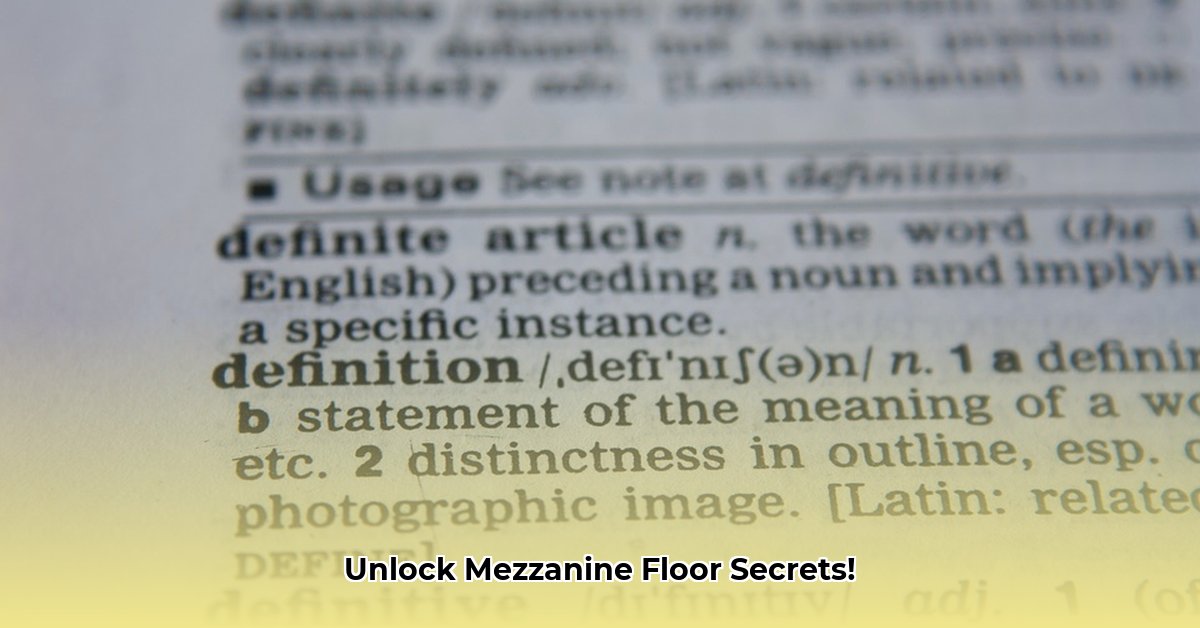Running out of room but don’t want to build a whole new addition? A mezzanine floor might be your answer! This guide will walk you through everything you need to know about them, from what they are and how they’re used, to the details of planning, building, and keeping them safe and useful over the long haul. We’ll explore different types of mezzanine floors, showing you their pros and cons, and give you a detailed guide to help you get one installed. You’ll learn how mezzanines can save you money, how to keep them in tip-top shape, and see real-world examples of where they work best. For more information, check out this helpful resource on [mezzanine floors](https://www.wavesold.com/what-is-a-mezzanine-floor). Let’s get started and see how a mezzanine floor can revolutionize your space.
Definition of Mezzanine Floor: Unveiling Versatile Space Solutions
What exactly constitutes a mezzanine floor?
Imagine adding a new floor to your building, but instead of building outwards or upwards, you’re building inwards. That’s essentially what a mezzanine floor is – an intermediate level built within the existing space of a high-ceilinged building. It’s a clever way to boost your usable square footage without the hassle (and cost!) of major construction. Think of it as a bonus level, adding valuable space without changing the building’s footprint. It offers numerous advantages: getting more space and saving money compared to expanding outwards.
Types of Mezzanine Floors: Finding the Right Fit
Selecting the right mezzanine floor depends on various space situations.
There are several types of mezzanine floors, each ideal for different applications. Think of it like choosing the right tool for the job – each type has specific strengths.
-
Free-Standing Mezzanines: Picture a completely independent structure, not relying on existing building supports. These are super versatile and perfect for large, open areas where you need a completely flexible solution. They are very adaptable to the space and can easily accommodate changes as your needs evolve. Because they don’t depend on the building’s structure, they can be placed almost anywhere.
-
Rack-Supported Mezzanines: These are designed to cleverly integrate with your existing storage racking. This is a great choice for warehouses seeking to maximize storage space, as they use the racks themselves for support. It helps boost both storage capacity and usable floor space. Imagine using the support beams of existing shelving to bear the load of the new floor. Clever, right? They are particularly cost-effective.
-
Building-Supported Mezzanines: These mezzanines rely on the existing building’s walls and columns for support. They’re typically integrated into the building’s design during construction but can sometimes be added later.
-
Hybrid and Custom Mezzanines: Many mezzanine designs are a blend of these styles or are completely bespoke – crafted to meet incredibly specific needs. For example, a manufacturer might need a mezzanine that combines elements of rack-supported for storage and free-standing to incorporate office space.
The best type for your situation depends greatly on factors like how much weight the floor needs to support, the height of your ceilings, the building’s structure, and what you intend to use the extra space for. Consulting with a structural engineer is crucial in making this determination.
Design Considerations: Planning for Success and Safety
Design considerations are a vital part of a mezzanine floor structure’s security.
Building a safe and effective mezzanine demands careful thought, a bit like building with LEGOs but on a much larger scale! Let’s explore the key factors to consider.
-
Load Calculations: The Weighty Matter. This is crucial. You absolutely need to know precisely how much weight your mezzanine floor will need to bear. Underestimating this can lead to a collapse (a really bad day!), while overestimating just wastes money and resources. A qualified structural engineer is a must – they’ll perform the necessary calculations and ensure the safety and stability of your build. They’ll assess the weight of people, equipment, stored materials, and even potential snow loads if the mezzanine is near the roof.
-
Choosing the Right Materials: Strength and Style. Material selection is key. Steel is often favored for its strength, durability, and fire resistance. However, wood might be a suitable option for lighter loads and specific aesthetics, offering a warmer, more traditional look. Concrete is also a possibility, offering excellent soundproofing and vibration dampening, but its weight and installation complexity must be carefully considered. Composite materials are also gaining popularity for their lightweight and strength. Each material has its pros and cons, and the best choice depends on several factors, including cost, load requirements, aesthetic preferences, and building codes.
-
Navigating Building Codes and Regulations: The Legal Side. Building a mezzanine isn’t just about building; it’s about following the rules. You need to comply fully with all relevant building codes, including local, state, and national regulations. This often involves securing the necessary permits. These codes cover aspects like fire safety, structural integrity, and accessibility. Ignoring this is risky – you could face fines, legal issues, or even be forced to tear down your new floor. Plus, it’s just good practice to ensure safety and compliance.
-
Safety Features: A Non-Negotiable Priority. Safety is paramount. Imagine adding guardrails and handrails to prevent falls, ensuring safe stairs and secure walkways. Fall protection systems are vital, and clearly marked and accessible emergency exits are essential. Fire suppression systems, such as sprinklers, may also be required. Make sure these follow all relevant safety standards, including OSHA guidelines in the US. Regular safety inspections are also crucial.
-
Accessibility: Creating an Inclusive Space. Your mezzanine design should prioritize access for everyone, including people with disabilities. This means considering things like ramps, elevators or platform lifts, and providing enough clear floor space to easily accommodate wheelchairs. Meeting ADA standards (Americans with Disabilities Act) is crucial for inclusive design in the US. Other regions have similar accessibility requirements.
-
Lighting and Ventilation: Adequate lighting is essential for safety and productivity. Consider natural light sources as well as energy-efficient lighting fixtures. Proper ventilation is also important to ensure air quality and prevent the buildup of fumes or odors.
-
Fire Safety: Fire safety is a critical consideration. Ensure that the mezzanine has adequate fire exits, fire-resistant materials, and fire suppression systems. Compliance with fire safety codes is essential to protect occupants and the building.
The Installation Process: From Blueprint to Reality
How is the mezzanine floor installed?
Building a mezzanine is a multi-step process, much like a recipe that needs to be followed carefully. Professional installation is key to a successful outcome.
Step 1: Planning and Design: This involves creating detailed plans, specifying materials, and outlining safety features. Your engineer’s calculations and the architects’ drawings form a critical part of this phase. This also includes defining the scope of the project and setting a realistic budget.
Step 2: Permitting and Approvals: Before you even think of lifting a hammer, obtain all necessary permits and approvals from relevant authorities. This may involve inspections to ensure the plans meet building codes and zoning regulations. This step can take time, so it’s important to start early.
Step 3: Construction and Installation: The actual building of the mezzanine happens in this phase, carefully following the approved plans. This typically involves assembling the structural framework, installing the flooring, and adding safety features. Regular inspections are essential throughout this step to verify that everything meets the plans and building codes.
Step 4: Final Inspection and Sign-off: Once construction is complete, this usually involves a final inspection by authorities to ensure everything complies with building codes and safety regulations. Only after successful sign-off is your mezzanine ready for use.
Maintenance and Inspection: Keeping it Safe and Sound
To maintain a mezzanine floor, regular maintenance and inspection is very important.
Regular maintenance and inspections are vital for a long lifespan and, importantly, safety.
-
Routine Inspections: Schedule regular checks to spot any signs of damage or wear early. Look for things like loose bolts, cracks in the flooring, or damaged handrails. Little issues are easier, and cheaper, to fix than large issues. Keep a log of all inspections and maintenance activities.
-
Preventative Maintenance: Address any problems promptly – a small crack might become a large crack if ignored. This might involve tightening bolts, repairing damaged flooring, or repainting surfaces.
-
Professional Inspections: Regularly schedule inspections from a qualified structural engineer. They’ll give you peace of mind and identify any potential concerns that might not be obvious to the untrained eye. They can assess the structural integrity of the mezzanine and recommend any necessary repairs or upgrades.
Cost Considerations: Balancing Budget and Long-Term Value
What are the cost and benefit trade-offs for mezzanine floors?
While the initial cost varies based on size, materials, and complexity, a mezzanine is often more economical than expanding your building’s footprint. Costs include materials, labor, and the permitting process. The cost of materials will depend on your selection. Don’t forget that prioritizing safety features is an investment that saves you big problems later. Consider the long-term benefits of a mezzanine, such as increased storage space, improved efficiency, and enhanced property value. These benefits are more than countered by improved efficiency and useable space.
Case Studies: Real-World Applications
Three industries that use mezzanine floors.
- Warehouse: A mezzanine added office space and increased storage in a warehouse, improving efficiency and organization. It allowed them to make better use of vertical space, reducing the need for off-site storage
- Glass Tile Shower Ideas to Create a Stunning Bathroom Space - December 7, 2025
- Glass Wall Tile Ideas for Kitchens and Bathrooms - December 6, 2025
- Glass Tile Bathroom: Create a Beautiful, Easy-Clean Space - December 5, 2025










